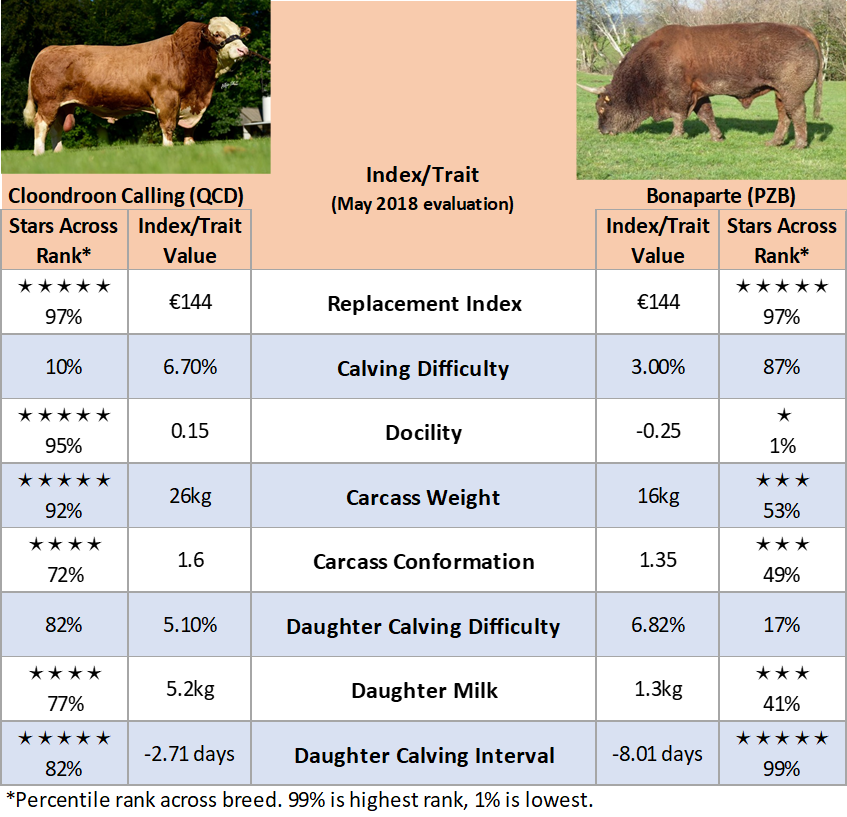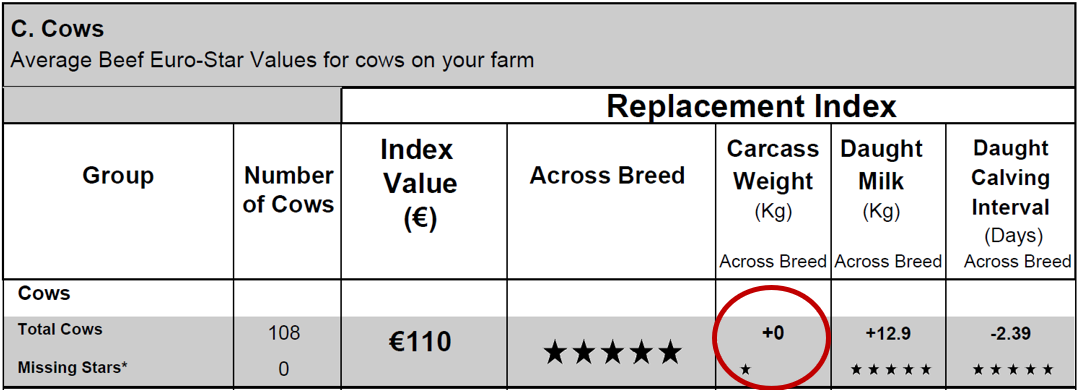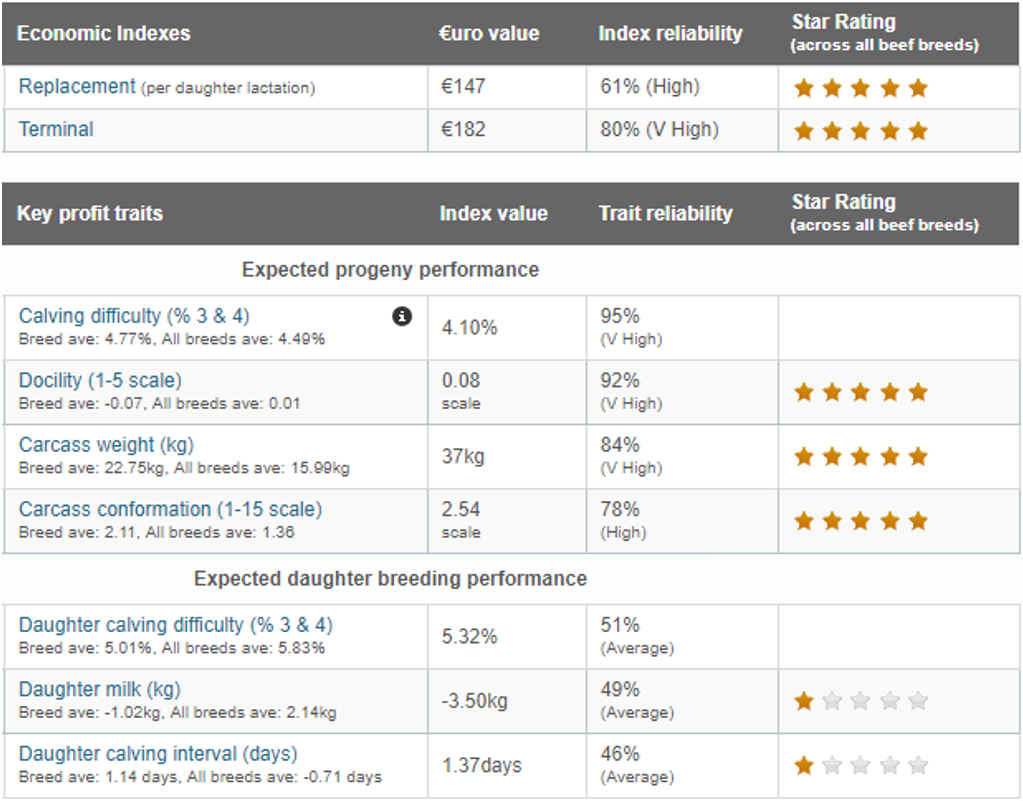Not necessarily. While the Euro-Star Replacement Index gives you a good idea at first glance as to the suitability of a bull to breed replacement females, it does not tell the whole story. If asked to list the most important attributes of a suckler cow, most farmers would say milk, fertility, calving ability and docility. These are generally accepted as universally important characteristics for a productive suckler cow. A high Replacement Index bull, however, will not necessarily guarantee all of these things.
Case study of two AI bulls with the same Replacement Index:
Cloondroon Calling (QCD) vs Bonaparte (PZB)
The following case study demonstrates the potential trait differences between bulls with the same Replacement Index. Both bulls have a Replacement Index of €144 @84% reliability (May 2018 evaluation). Despite this, they may produce very different progeny. Without scrutinising the individual traits (calving, carcass, milk, etc.) of each bull, it is impossible to tell their strengths and weaknesses (see Table 2).

There are differences across all of the traits, with some being very significant. If you look at docility, for example, QCD ranks in the top 5% across breeds while PZB ranks in the bottom 1%. If a particular farmer wanted to make improvements in the temperament of their animals, selecting between these two bulls on the Replacement Index alone could lead to a completely unsuitable bull being chosen.
Does the perfect bull exist?
Maybe it does, but it is an elusive animal. Every farmer would love a bull that is easy calving, short gestation and produces docile animals that exhibit rapid growth rates and extreme conformation, while his daughters are capable of calving at 24 months with minimal calving difficulty, produce lots of milk, wean excellent quality calves and last in the herd for a long number of years as efficient suckler cows. Not easy to find, right? It is not realistic to expect a bull to do all of the above.
So, what can I do to select the most suitable bull(s) for my herd?
Interpretation is probably the most important word in this process. Selecting the most suitable breeding animals for your herd requires correct interpretation of the information available to you. The following are 3 simple steps that can help you select the most suitable animals for your herd.
- Identify your farming system and the type of animal you are trying to produce.
- There are many different systems on Irish suckler farms.
- The traits required for a herd producing weanlings for the export market will be very different to a herd producing replacement females.
- You may require a bull for replacement heifers, in which case calving difficulty is the most important trait to look at.
- Identify the strengths and weaknesses of your cows.
- Use the first (summary) page of the HerdPlus Euro-Star report to do this.
- This will show you where your herd ranks on the Replacement Index as well as other key traits including carcass, milk and calving interval (see Figure 1).

- Select bulls to improve on your cow’s weaknesses.
- Genetic gain should be driven in a herd through proper sire selection.
- A new stock/AI bull should always be genetically superior to your cows on the traits that you need to improve on. The example herd in Figure 1 requires a bull with a very high carcass weight figure.
Is it possible for a high Replacement Index bull to be poor on some of the key maternal traits?
Yes, it is. While it is unusual it is possible. As already shown in Table 1, there are a lot of other traits included in the Replacement Index outside of milk, fertility and calving ability. These traits heavily influence the overall Replacement Index figure so bulls that are poor on these traits will only have a high Replacement Index if they are exceptionally strong on the other traits e.g. carcass, calving, cow liveweight, etc. Figure 2 is an example of a bull with a high Replacement Index, but low on maternal traits.

As already stated, interpretation is key. The bull in Figure 2 would be perfectly suited to a herd that is already strong on milk and fertility and requires a big improvement in carcass traits, but is not at all suited to a herd that requires improvement in milk or fertility. This example demonstrates perfectly why it is important to go further than just the Replacement Index and to scrutinise the individual traits of a bull as well.
If you are unsure, ask.
For some, Euro-Stars, trait values, reliabilities, etc. can all be a little overwhelming. A lack of understanding should not, however, mean that they are disregarded. Most people nowadays drive cars, but not all of us would know how to fix our car if a particular problem arose. So, what would we do? We would get help from somebody that does know how to fix the problem. Disregarding it will only lead to bigger problems down the road. If you are unsure about how to properly interpret the Euro-Star Index, speak to somebody that can. You can talk to your agricultural advisor or call ICBF on 023-8820452 or email [email protected].
This article has been prepared by ICBF in good faith on the basis of information provided to it. No representation or warranty expressed or implied is made or given by ICBF as to the accuracy, reliability, completeness of this article. ICBF shall not be liable for any losses (whether direct or indirect), damages, costs or expenses whatsoever, incurred or arising from any use of or reliance on this article or the information contained in it by any person.
